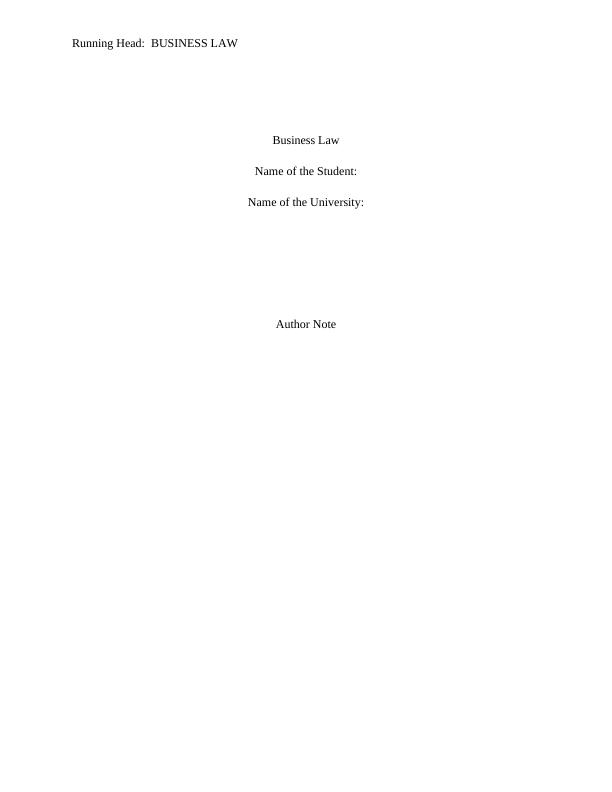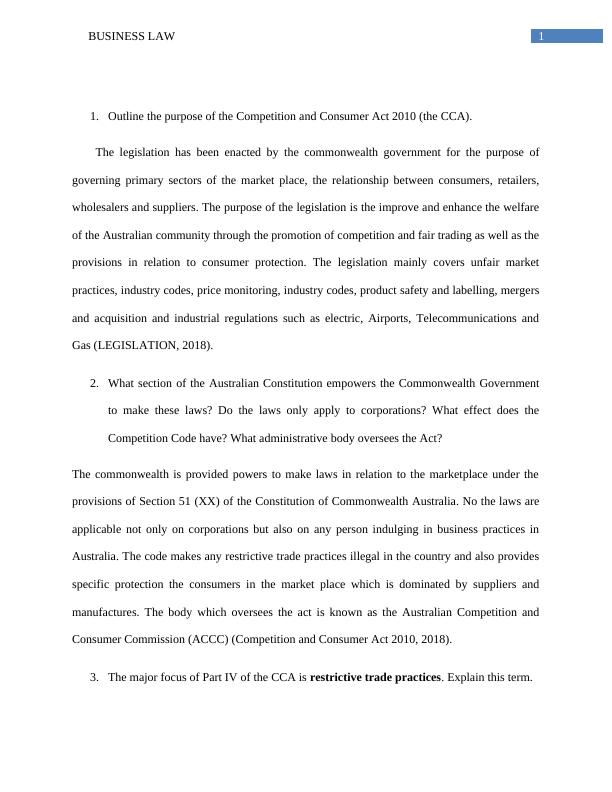Business Law
Added on 2023-06-14
8 Pages1944 Words229 Views
Running Head: BUSINESS LAW
Business Law
Name of the Student:
Name of the University:
Author Note
Business Law
Name of the Student:
Name of the University:
Author Note

1BUSINESS LAW
1. Outline the purpose of the Competition and Consumer Act 2010 (the CCA).
The legislation has been enacted by the commonwealth government for the purpose of
governing primary sectors of the market place, the relationship between consumers, retailers,
wholesalers and suppliers. The purpose of the legislation is the improve and enhance the welfare
of the Australian community through the promotion of competition and fair trading as well as the
provisions in relation to consumer protection. The legislation mainly covers unfair market
practices, industry codes, price monitoring, industry codes, product safety and labelling, mergers
and acquisition and industrial regulations such as electric, Airports, Telecommunications and
Gas (LEGISLATION, 2018).
2. What section of the Australian Constitution empowers the Commonwealth Government
to make these laws? Do the laws only apply to corporations? What effect does the
Competition Code have? What administrative body oversees the Act?
The commonwealth is provided powers to make laws in relation to the marketplace under the
provisions of Section 51 (XX) of the Constitution of Commonwealth Australia. No the laws are
applicable not only on corporations but also on any person indulging in business practices in
Australia. The code makes any restrictive trade practices illegal in the country and also provides
specific protection the consumers in the market place which is dominated by suppliers and
manufactures. The body which oversees the act is known as the Australian Competition and
Consumer Commission (ACCC) (Competition and Consumer Act 2010, 2018).
3. The major focus of Part IV of the CCA is restrictive trade practices. Explain this term.
1. Outline the purpose of the Competition and Consumer Act 2010 (the CCA).
The legislation has been enacted by the commonwealth government for the purpose of
governing primary sectors of the market place, the relationship between consumers, retailers,
wholesalers and suppliers. The purpose of the legislation is the improve and enhance the welfare
of the Australian community through the promotion of competition and fair trading as well as the
provisions in relation to consumer protection. The legislation mainly covers unfair market
practices, industry codes, price monitoring, industry codes, product safety and labelling, mergers
and acquisition and industrial regulations such as electric, Airports, Telecommunications and
Gas (LEGISLATION, 2018).
2. What section of the Australian Constitution empowers the Commonwealth Government
to make these laws? Do the laws only apply to corporations? What effect does the
Competition Code have? What administrative body oversees the Act?
The commonwealth is provided powers to make laws in relation to the marketplace under the
provisions of Section 51 (XX) of the Constitution of Commonwealth Australia. No the laws are
applicable not only on corporations but also on any person indulging in business practices in
Australia. The code makes any restrictive trade practices illegal in the country and also provides
specific protection the consumers in the market place which is dominated by suppliers and
manufactures. The body which oversees the act is known as the Australian Competition and
Consumer Commission (ACCC) (Competition and Consumer Act 2010, 2018).
3. The major focus of Part IV of the CCA is restrictive trade practices. Explain this term.

2BUSINESS LAW
The antitrust or restrictive trade provisions provided through part IV of the CCA have the
purpose of addressing the restriction of those practices which anti competitive in nature and are
put in place by the business in order to minimise or prevent free competition. Restrictive trade
practices include practices like boycott agreements, price fixing, misusing market power,
excusive dealings, resale price maintenance and mergers and acquisitions. These practices are
put into place by the businesses to ensure that Monopoly is established and their bargaining
power in the market is increased and they can make additional practices (Australian Competition
Law | Overview, 2018).
4. There are six main types of restrictive trade practices which are prohibited. Explain
each of these by referring to the specific section of the CCA and by using appropriate
specific cases.
There are six primary types of respective trade practices which are in place as provided under
part IV of the CCA. These are as follows:
Cartel Conduct
Division 1 of Part IV of the Competition and Consumer Act 2010 (CCA) imposes prohibition
upon cartel conduct. Cartel conduct is not only a civil penalty provision but also can be
considered as a criminal offence. There are primarily four activities which are included in Cartel
conduct which are defined under section 45AD of the CCA. These activities are that of Price
Fixing, Market division, bid rigging and Restricting outputs. The activity is made illegal in
situation where it is provided effect in an understanding, arrangement or contract and the parties
The antitrust or restrictive trade provisions provided through part IV of the CCA have the
purpose of addressing the restriction of those practices which anti competitive in nature and are
put in place by the business in order to minimise or prevent free competition. Restrictive trade
practices include practices like boycott agreements, price fixing, misusing market power,
excusive dealings, resale price maintenance and mergers and acquisitions. These practices are
put into place by the businesses to ensure that Monopoly is established and their bargaining
power in the market is increased and they can make additional practices (Australian Competition
Law | Overview, 2018).
4. There are six main types of restrictive trade practices which are prohibited. Explain
each of these by referring to the specific section of the CCA and by using appropriate
specific cases.
There are six primary types of respective trade practices which are in place as provided under
part IV of the CCA. These are as follows:
Cartel Conduct
Division 1 of Part IV of the Competition and Consumer Act 2010 (CCA) imposes prohibition
upon cartel conduct. Cartel conduct is not only a civil penalty provision but also can be
considered as a criminal offence. There are primarily four activities which are included in Cartel
conduct which are defined under section 45AD of the CCA. These activities are that of Price
Fixing, Market division, bid rigging and Restricting outputs. The activity is made illegal in
situation where it is provided effect in an understanding, arrangement or contract and the parties

End of preview
Want to access all the pages? Upload your documents or become a member.
Related Documents
Criminal Law Australia case Study 2022lg...
|6
|1618
|20
Cartel Conduct and Prohibited Anti-Competitive Practices: Analysis under the Competition and Consumer Actlg...
|8
|2495
|284
Consumer Protection and Product Liability Lawlg...
|10
|3419
|470
Competition law Assignment Solutionlg...
|10
|2755
|54
Competition and Consumer Law: Applicability, Remedies and Penaltieslg...
|9
|2401
|470
Monopolies and Anti competitive legislation in UKlg...
|12
|992
|465
